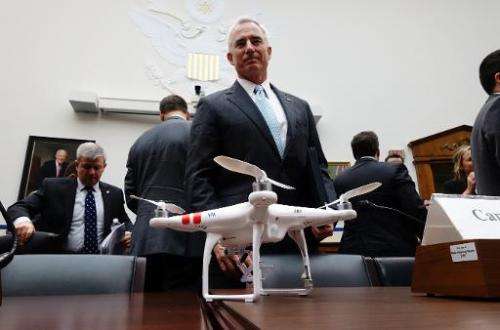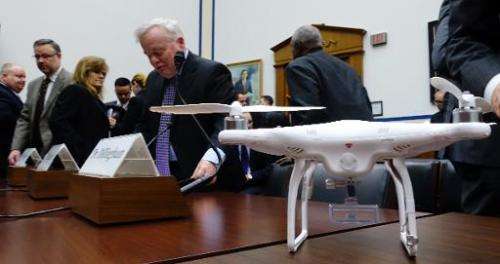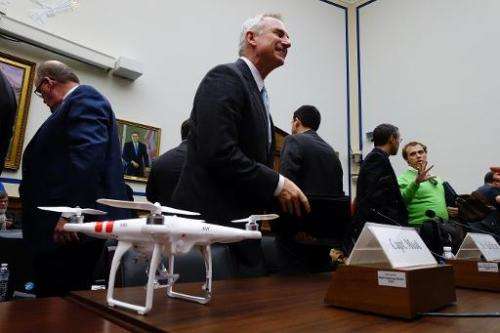Top pilot sees risk in unregulated US drones

Small drones pose a danger in US skies so long as clear rules governing their operation are not in place, the head of the world's biggest pilots' union said Wednesday.
Lee Moak, president of the Air Line Pilots Association, International (ALPA), issued the warning—with his own personal drone in hand—at a Capitol Hill hearing into unmanned aircraft vehicles, or UAVs.
"We recognize the potential benefits (of drone technology) to our nation's economic competitiveness," Moak told members of the House of Representatives transportation committee.
"But we also recognize the potential for a safety risk if we don't treat them for what they are—airplanes in airspace," he said.
The Federal Aviation Administration (FAA) has yet to come up with a dedicated set of rules for low-flying drones under 55 pounds (25 kilograms)—a category that includes consumer models that are set to be this year's hot Christmas gift.
"We all agree that the project is taking too long," said Margaret Gilligan, the FAA's associate administrator for aviation safety.
Fellow FAA safety official Matthew Hampton acknowledged, however, that it was "uncertain" when final regulations would be published.
Rules running late
Gerald Dillingham of the Government Accountability Office, the non-partisan research arm of Congress, doubted that regulations could be enacted before 2017—two years later than initially anticipated.

Drones are widely seen as the next big thing in technology, with applications as far-ranging as movie-making and law enforcement to building-site inspections and pipeline patrols.
But the Association for Unmanned Vehicles International, a trade group, estimates that the US economy will lose $10 billion a year so long as drone-specific regulations are lacking.
Amazon has said it might shift its nascent drone parcel delivery project overseas if the FAA keeps stalling on its application to test drones in its home state of Washington.
In the absence of clear regulations, the FAA virtually bans the use of drones of any size for commercial purposes without its express authorization. It also limits amateur flying to no higher than 400 feet, well away from airports.
Just prior to Wednesday's hearing on Capitol Hill, the FAA exempted four companies—in the aerial surveying, construction site monitoring and oil rig flare stack sectors—from that ban.
It had earlier issued similar exemptions to seven film and video production outfits, with strict restrictions on flight operations attached.

Close encounters
Wednesday's hearing followed a recent Washington Post report that the FAA has been getting about 25 reports a month from pilots about close encounters with drones.
To back up his testimony, Moak brought along a DJI Phantom 2, a popular consumer drone, which bought online a week ago "for a few hundred dollars" and has already flown inside his office.
"It has the capability, this one, to fly as high as 6,600 feet (2,000 meters) for 15 minutes," the Delta Air Lines Boeing 767 captain testified.
"That means it could easily end up in the same airspace that I occupy when I am on approach to land at Newark or at Seattle or at any other airport," he said.
Moak likened the potential for damage to a mid-air bird strike, as he presented a photo of a C-130 Hercules transport aircraft with a left wing smashed during "an encounter" with a drone.
© 2014 AFP



















